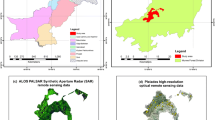Abstract
The study presents digital preprocessing techniques, visual mapping capability of airborne X-band SAR data having diverse vegetation types in tropical wet climate. Spatial textural analysis methods have also been evaluated to enhance discriminability of the forest types and features. Attempt has been made to enhance the information by merging optical remote sensing data with microwave X-band response. Finally, the backscattering digital values have been correlated with qualitative and quantitative vegetation parameters. The Leaf Area Index has shown significant relationship with SAR image digital number value.
Similar content being viewed by others
References
Anonymous (1989). Sunfleck Ceptometer User’s Manual. CEP-UM6 Delta-T Devices Ltd. 128 Law Road, Burwell, Cambridge CB5 OEJ, England, pp. 1–28.
Dobson M C, Pierce L, Sarabands K, Ulaby F T and Terry Sharik (1992). Preliminary analysis of ERS-1 SAR for forest eco-system studies. IEEE Transactions on Geoscience and Remote Sensing, Vol. 30, No. 2, pp. 203–211.
Evans D L, Farr T G, Fard J P, Thompson T W and Weiner C L (1986). Multipolarization radar image for geological mapping and vegetation discrimination. IEEE Transactions on Geoscience and Remote Sensing. Vol. GE-24, No. 2, pp. 246–256.
Ford J P and Wickland D E (1985). Forest discrimination with multipolarization imaging radar.Int. Geoscience and Remote Sensing Symposium Proceeding (IGARSS 1985) 7–9 October. University of Mass., Vol. 1, pp. 462–465.
Hoekman D H (1985). Radar backscattering of forest stands.Int. J. Remote Sensing, Vol. 6, No. 2, pp. 325–343.
Hoffer R M, Davidson S E, Muller P W and Lozano-Garcia D F (1985). A comparison of X and L-band radar data for discriminating forest cover types, Proc. of PECORA 10 -Remote Sensing in forest and range resource management, 20–22 Aug., 1985, Colorado State University, Fort Collins Co.
Hoffer R M (1986). Digital analysis techniques for forestry applications.Remote Sensing Reviews, Vol. 2, pp. 61–110.
Muller P W, Hoffer R M and Lozano-Garcia D F (1985). Interpretation of forest cover on microwave and optical satellite images. Proc. of PECORA 10 -Remote Sensing in forest and range resource management, 20–22 Aug., 1985, Colorado State University, Fort Collins Co., pp. 578–592.
Paris J F (1985). On the use of L-band multipolarization Airborne SAR for surveys of crops, vineyards and orchards in a California irrigated agriculture region. NASA/JPL aircraft. SAR workshop Proceedings 4–5 February, 1985. JLP Pasadena Ca., JPL Publication. 85–39, 15 June, 1985, pp. 1–63.
Roy P S, Ranganath B K, Diwakar P G, Vohra T P S, Bhan S K, Singh I J and Pandian V C (1991). Tropical forest type mapping and monitoring using remote sensing.Int. J. of Remote Sensing, Vol. 12, No. 11, pp. 2205–2225.
Roy P S and Ranganath B K (1993). Redefining forest management strategies using remote sensing. In ed. bookEnvironmental Crisis: Issues, Response and Management. ISBN: 81-7022-162, Concept Publishers, New Delhi, pp. 367–388.
Sader S A, Joyce A T, Waide R B and Lawrence W T (1985). Monitoring tropical forests from satellite and aircraft platforms: Some limitations and new approaches. In Proc. PECORA 10 -Remote sensing in forest and range resource management, Aug. 20– 22, 1985, Colorado State University, Fort Collins Co., U.S.A.
Sabins F F (1986). Remote Sensing - Principles and interpretation Pub. W.H. Freeman and Company, New York, pp. 177–233.
Sader S A (1987). Forest biomass, canopy structure and species composition relationships with multipolarized L-band Synthetic Aperture Radar Data.Photogrammetric Engg. and Remote Sensing, Vol. 53, No. 2, pp. 193–202.
Sieber A J (1985). Statistical analysis of SAR image.Int. J. Remote Sensing, Vol. 6, No. 9, pp. 1555–1572.
Solberg R (1992). Monitoring soil erosion in agricultural field by ERS-1 SAR. IGARSS, Vol. II, IEEE, CatlogNo. 92, CH 3041-1, pp. 1356–1359.
Wu S T (1981). Analysis of results obtained from integration of Landsat multispectral scanner and Seasat synthetic aperture radar data, NASA-NSTL Report No. 189, pp. 1–53.
Werle D (1989). Potential application of imageing radar for monitoring the depletion of tropical forests. Proc. IGARSS 1989, Vancouver, B.C. Canada, pp. 1383–1413.
Author information
Authors and Affiliations
About this article
Cite this article
Roy, P.S., Diwakar, P.G., Singh, I.J. et al. Evaluation of microwave remote sensing data for forest stratification and canopy characterisation. Journ. Ind. Soc. Remote Sensing 22, 31–44 (1994). https://doi.org/10.1007/BF03015118
Received:
Accepted:
Issue Date:
DOI: https://doi.org/10.1007/BF03015118




